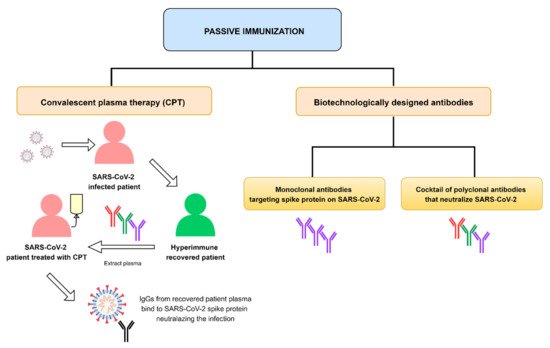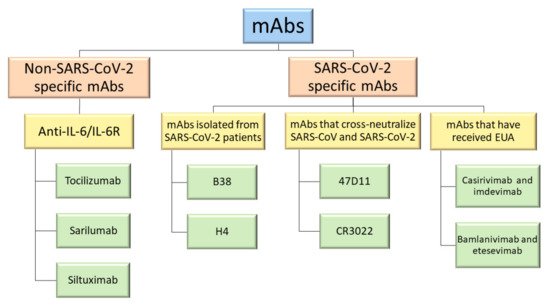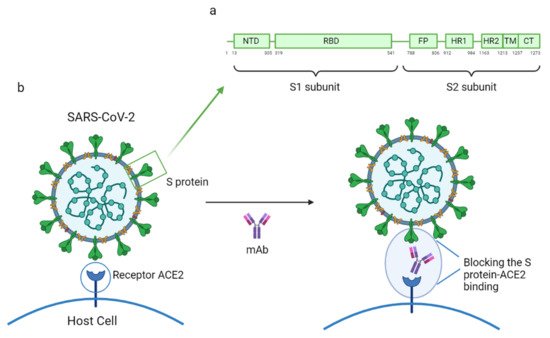Coronavirus disease 2019 (COVID-19), caused by severe acute respiratory syndrome coronavirus 2 (SARS-CoV-2), has emerged as a new infectious disease which has reached pandemic proportions. This coronavirus belongs to the
Betacoronavirus genus in the Coronaviridae family, together with other previously identified coronaviruses, such as SARS-CoV and MERS-CoV. These viruses have a positive-sense RNA genome which encodes structural and non-structural proteins
[1]. SARS-CoV-2 transmission is mainly mediated by respiratory droplets and aerosols and most infected patients are asymptomatic or present mild symptoms, such as fever, cough, dyspnoea, diarrhoea, muscle pain, sore throat, headache, and loss of smell and/or taste. However, about 20% of patients undergo a serious illness with dyspnoea, pneumonia, and supplemental oxygen requirements. The most seriously ill patients can suffer respiratory failure and cardiopulmonary collapse or shock that can lead to death
[2]. In response to this global emergency, a wide range of therapeutic agents such as chloroquine, hydroxychloroquine, antivirals, antibodies, corticosteroids, or convalescent plasma among others have been or are currently being evaluated for the treatment of COVID-19
[3], in addition to the development of vaccines. Unfortunately, not all these agents have proved successful and some, such as chloroquine, hydroxychloroquine and several antivirals, have already been discarded as possible treatments
[4][5][6].
One of the strategies considered for defeating COVID-19 is passive immunotherapy (). There are two ways to guarantee passive immunization: (i) via natural antibodies using convalescent plasma therapy (CPT) in which plasma is extracted from a hyperimmune patient and transfused into a COVID-19 patient; or (ii) via antibodies that are biotechnologically designed, i.e., therapeutic monoclonal antibodies (mAbs) or a cocktail of polyclonal antibodies (pAbs)
[7]. Of these two passive immunization strategies, the use of mAbs offer the most innovative approach to the prevention and treatment of infectious diseases, such as COVID-19, where current research aims at developing treatments based on specific mAbs to block and/or neutralize SARS-CoV-2 in infected patients
[8]. In addition, already available mAbs have been used off-label based on the knowledge acquired during the pandemic regarding the pathogenesis of the disease. Therefore, the characteristic of mAbs made them perfectly suitable for the treatment of COVID-19
[9].
The off-label use of drugs can be defined as their use for a non-officially approved condition. It also refers to the use of drugs with an unapproved dosage, route of administration, or in an unlicensed combination regimen
[10]. Off-label administration of drugs to treat COVID-19 is an extensive practice. However, this is not the first time that mAbs have been prescribed off-label. Several mAbs have proven safe and effective for treatments not indicated in their respective Summary of Product Characteristics (SPC). One example is bevacizumab: an anti-cancer biotherapeutic which is currently widely administered intravitreally to treat age-related macular degeneration (AMD) instead of the approved drug, ranibizumab
[11]. Although both biotherapeutics have similar efficacy and safety, bevacizumab is now preferred due to its better cost–benefit ratio.
Several clinical trials are currently being conducted to test the efficacy and safety of different mAbs for the treatment of COVID-19, some of which are already being administered in hospitals while others are under evaluation
[12]. Many of them target immune system responses (non-SARS-CoV-2 specific mAbs) while others are designed to neutralize the SARS-CoV-2 protein structure (SARS-CoV-2 specific mAbs) ()
[7].



